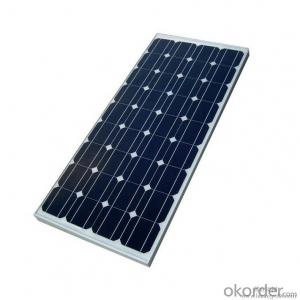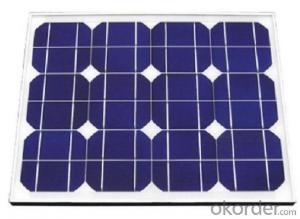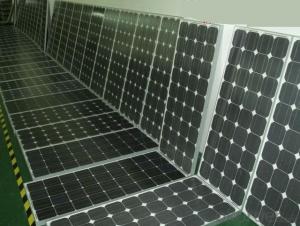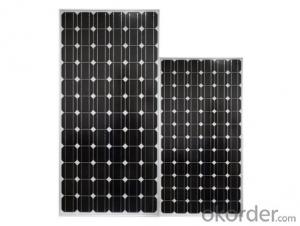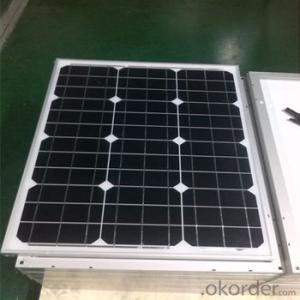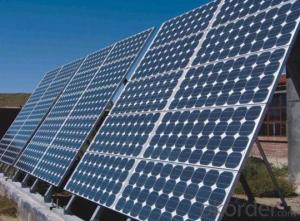55W18V Mono Solar Panel,High Quality,Hot Sales
- Loading Port:
- China main port
- Payment Terms:
- TT OR LC
- Min Order Qty:
- 500 watt
- Supply Capability:
- 100000 watt/month
OKorder Service Pledge
OKorder Financial Service
You Might Also Like
Structure
20W18V Mono Solar Panel,High Quality,Hot Sales
We are focus on 1w -100W solar modules with high quality and best price.
Mechanical Characteristics
Frame (Material, Comers, etc.) | Anodized Aluminium | ||
Front side | Glass | ||
Front glass thickness | 3.2mm | ||
Encapsulate | EVA | ||
Back side | TPT | ||
Junction box | IP65 | ||
MOQ: No.
Dlivery time: 5 days after deposit for small number, for large number, we will check and give exact reply Payment: 100% TT for small quantity; legal way is 30% deposit + 70% balance before shipment
Model:PS-20M-18V
size: 480*357*25mm or as required
Feature
Pure Sine Wave Output;
High performance Maximum Power Point Tracking(MPPT);
Power Automatically Locked(APL);
Reverse power transmission;
High-Frequency High Conversion Rate;
Anti-Islanding Protect;
Input /output is fully isolated to protect the electrical safety;
Multiple parallel stacking;
The Leading Patent Technology;
IP65 WaterProof;
Flexible Installation;
Simplify maintenance (user serviceable)
High Efficiency & Best Cost-Effectiveness
Image
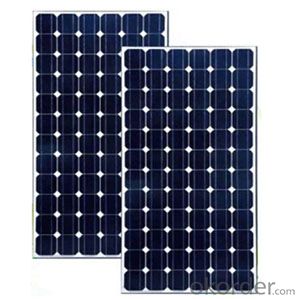
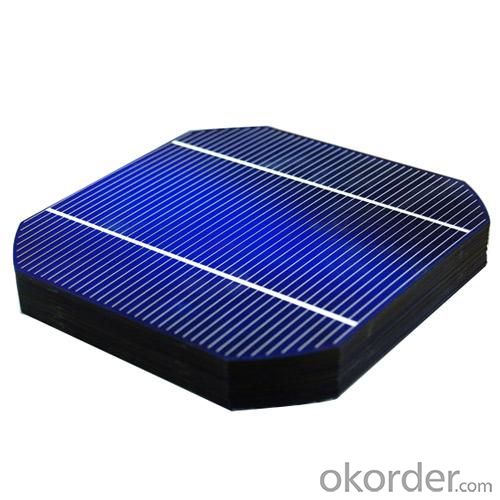
Specification
Model | PS-20M -18V |
Crystalline type | monocrystalline |
Maximum power (Wp) | 20 |
Maximum power voltage (V) | 17.2 |
Maximum power current (A) | 1.18 |
Open circuit voltage (V) | 21.4 |
Short circuit current (A) | 1.30 |
Number of cells (Pcs) | 36 |
Size of module (mm) | 475*350*25mm or as required |
Maximum system voltage (V) | 715 |
Temperature Range | -40~+85 C |
Surface Maximum Load Capacity | 60m/s(200kg/sq.m) |
Allowable Hail Load | steel ball fall down from 1m height |
Weight per piece (kg) | 1.8 |
Length of Cables (mm) | 300 |
Cell Efficiency (%) | >17.6% |
Module Efficiency (%) | >12% |
Output tolerance (%) | +/-5% |
Frame (Material, Corners, etc.) | Aluminum |
Standard Test Conditions | AM1.5 1000W/m2 25 |
FF (%) | 72% |
Warranty | 2 years product warranty and 25 years 80% of power |
FAQ
Can we visit your factory?
Surely, I will arrange the trip basing on your business schedule.
Can you do OEM for us?
Yes, we can.
How do you pack your products?
We have rich experience on how to pack the panels to make sure the safety on shipment when it arrives at the destination.
Can you help us install the module if we cooperate with you?
We haven’t entered into installation sector, but we have the plan in near future.
- Q:I want to build a solar panel
- Here okorder /
- Q:Could you have a solar panel in space that would transmit electricity remotely? Maybe have some kind of receiving antenna to pick up the energy? Perhaps there could be a string of them orbiting the Earth?Why wouldn't that work?
- Absolutely. Many satellites and other spacecraft that have been launched throughout history carry solar panels to power themselves. The International Space Station alone has hundreds of square meters of solar panels. Transmitting the power from one place to another wirelessly is a bit more difficult, but not fundamentally impossible. So far we don't have any good technology to do it over long distances. But we're getting there. One proposed future source of power is 'solar power satellites', orbiting devices that would collect sunlight and turn it into a microwave laser that would be fired down to the Earth and collected in a giant dish kind of like a radio telescope. The idea is that this would be non-polluting, environmentally friendly, reliable, would help to boost investment in space technologies, and wouldn't take up the large amounts of land area required for traditional solar power. However, some people have argued that it is a bad idea on the basis that if the laser accidentally missed the dish, and came down in an inhabited area, it might cause human fatalities or damage to the environment or human artifacts.
- Q:Around this time here in Georgia we will begin to get some big storms with high winds. I have a solar panel on a mount that isn't all that sturdy and could be knocked over with any winds pretty much above 5mph. I can't put anything in the ground to do this. I used to have it mounted to the roof of a playground for the most sunlight, but because of the angle of the sun and the tree leaves, I have to have it on a quot;portablemount so I can move it throughout the day, and I can tell you one thing is certain, and that's that it isn't the most sturdy thing ever. I'll have it a little better next weekend but it'll still be able to easily blow in the wind. Should I just hang the panel along the wall during a storm then reconnect it to its base once it's over?I'm pretty good with wood, so any wood creations to help out with the thing would greatly help. Just please keep it on a low budget.
- You have to make the decision weather you want it portable or stationary. If you want stationary I would make some good brackets for them / search for cheap ones on OKorder. I'd have to see them to be able to offer any better suggestions. It's always hard to decide so you'll have to take notes and do research.
- Q:For those solar panels that you install on your rooftops, do they generate electricity when it's cloudy? And if yes, how much electricity does it generate compared to sunny days? For example...like only 25% electricity generated compared to sunny days?
- Yes. If there is any light, even on a cloudy day, a solar panel can generate power. But the amount of power generated is much less when the solar panel is not in direct sunlight (about 90% less). On a cloudy day, typical solar panels can produce 0-25% of their rated capacity. The exact amount will vary depending on the density of the clouds, and may also vary by the type of solar panel; some kinds of panels are better at receiving diffuse light. SunPower solar cells, for example, have been designed to capture a broader range of the solar spectrum. By capturing more red and blue wavelengths, their solar panels can generate more electricity even when it’s overcast. Ultraviolet light also reaches the earth’s surface in abundance during cloudy days (if you’ve ever been at the beach when it’s cloudy and gotten a sunburn, you’ve experienced this firsthand). Some solar cells are in development that can capture UV rays, although these are not out on the market yet. Even with a standard solar panel on a cloudy day, though, you will be able to generate some power when it’s daylight. The same thing is true in foggy weather. If you live in a city with frequent fog, like San Francisco, you’ll still be able to generate electricity when the fog rolls in. :)
- Q:Can solar panels be connected directly to motor?
- Power supply must be a number of individual battery strings, connected in parallel and tightly packaged into components.
- Q:Pretty much, can solar panel's support the entire houses electrical needs generally, because I know sometimes the owner's can sell unused electricity back, any ideas or any ideas on how much the average home uses in kWh
- why okorder and we will tell you and everyone else what they would need.we will tell you to the dollar what it takes to accomplish your desire.thanks tommy
- Q:I need to build a battery array to use with my solar panels I just bought. I want to be able to store enough energy to be draw from it at night, possibly around the clock. Is there a down side to using the deep cycle battery I bought from autozone and 6 or 7 more just like it, or do I need to get some other battery?
- There are batteries particularly made for solar, such as the Trojan T05-RE . I think the RE stands for renewable energy. A deep cycle battery should work all right, although not quite as well. What you want to do is try out your setup first, with just one battery, and the panels provided. If this is one of those 45 watt kits, you may be surprised at how little energy you actually get from the panels. Increasing the number of batteries won't help, either - that's like getting a larger water tank, when you only have a trickle to fill it. If your goal is really to save money, the most cost-effective solar is the grid-tied type, with no batteries at all. That's what we have, and I've never regretted it.
- Q:Well I was thinking about the idea of renovating either a smaller school bus or building a tiny house and I was wondering if i can get some information on the size and watts panel should I use or more like how to get that whole solar energy in motion. Any infor and links would help
- I think that typical solar panels are 2'x4' and produce something like 800-000 wh per day. (That's 0.8 - kwh per day.) More in the summer, less in the winter, if they're aimed sort of at the sun. There are newer, more expensive panels that produce more. There are also thin film panels that are less expensive, and probably more sturdy. You then have a couple choices. In a house, you'd have an expensive inverter to connect to the utility power, so you can have power at night when your panels aren't generating anything. In a trailer, you want 2-4-6 deep cycle car batteries to store the power. Then you could have an inverter to convert that power to 20v AC, so you could use normal appliances. Or, you could buy appliances that run on 2 volts DC. Maybe a combination of both. You'll need to figure out how much power you're going to use, so you know how many panels and batteries you're going to need. The calculation is easy. Figuring out how much power you need is hard. You need deep cycle batteries because you can repeatedly charge them way up and run them way down. Ordinary batteries die fairly quickly when you do that.
- Q:i also need to know how does a solar panel work
- solar panel convert sunlight into electricity,The controller is connected between the photovoltaic panels and batteries,it makes electricity generated from solar panels charge batteries.
- Q:They absorb solar heat and transform it into electricity, so there should be less heat left to warm the planet. Shouldn't we at least plaster all the world's deserts with them?
- The opposite - they heat the Earth up. The ground underneath might be brown or green or sand. The solar panels are Black. They absorb more radiant energy. Solar electricity is energy and somewhere down the wire will produce heat. Solar's saving grace is that it has the same heating effect year after year. But greenhouse gasses have a cumulative effect. The excess gasses produced in year one are added to the gasses in year two, etc. For instance say the heating of soalr cells is 5 times (5s) that of greenhouse gasses (g). Year - Total Heating - 5s + g 2 - 5s + 2g 3 - 5s + 3g 4 - 5s + 4g 5 - 5s + 5g 6 - 5s + 6g 7 - 5s + 7g 8 - 5s + 8g 9 - 5s + 9g 0 - 5s + 0g etc... In 50 years you have 50 - 5s + 50g
1. Manufacturer Overview |
|
|---|---|
| Location | |
| Year Established | |
| Annual Output Value | |
| Main Markets | |
| Company Certifications | |
2. Manufacturer Certificates |
|
|---|---|
| a) Certification Name | |
| Range | |
| Reference | |
| Validity Period | |
3. Manufacturer Capability |
|
|---|---|
| a)Trade Capacity | |
| Nearest Port | |
| Export Percentage | |
| No.of Employees in Trade Department | |
| Language Spoken: | |
| b)Factory Information | |
| Factory Size: | |
| No. of Production Lines | |
| Contract Manufacturing | |
| Product Price Range | |
Send your message to us
55W18V Mono Solar Panel,High Quality,Hot Sales
- Loading Port:
- China main port
- Payment Terms:
- TT OR LC
- Min Order Qty:
- 500 watt
- Supply Capability:
- 100000 watt/month
OKorder Service Pledge
OKorder Financial Service
Similar products
New products
Hot products
Hot Searches
Related keywords
